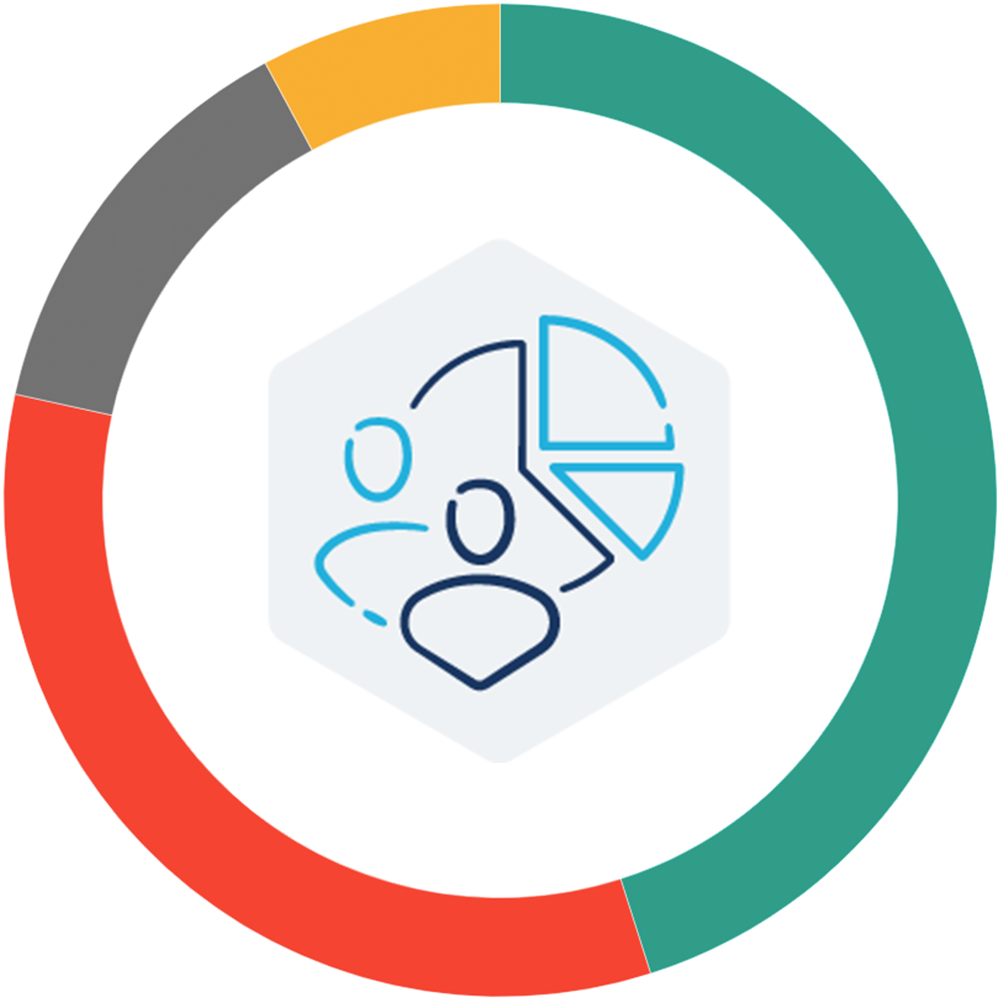Workforce Data
Download Workforce DataThe absence of good data allows anecdote and bias to drive policy decisions. Without quality comprehensive data, it’s impossible to answer key policy questions, much less develop estimates of the level of public funding needed to recruit and retain a qualified ECE workforce.1McLean, C., & King, C. (2019). A Workforce Data Deficit Hinders Improved Preparation, Support, and Compensation of Early Childhood Educators. Berkeley, CA: Center for the Study of Child Care Employment, University of California, Berkeley. Retrieved from https://cscce.berkeley.edu/a-workforce-data-deficit-hinders-improved-preparation-support-and-compensation-of-early-childhood-educators/.
Nationwide, leaders lack answers to critical questions about educators who work with young children. Questions like: Who constitutes the early childhood workforce throughout the United States? How does the ECE workforce vary by state, district, and territory? What are their current education and compensation levels? Which educators receive crucial supports like paid time for planning and reflection to improve their practice in the classroom? Are documented racial and other inequities in the field being eliminated, exacerbated, or remaining stagnant?2Moving forward, it is critical that state data systems allow for nuanced analyses in order to disrupt inequities: at the national level, wage disparities exist for various groups within ECE, including educators of color and infant/toddler teachers, as well as between educators working in schools and those working in community-based settings. See Whitebook, M., McLean, C., Austin, L.J.E., & Edwards, B. (2018). Early Childhood Workforce Index – 2018. Berkeley, CA: Center for the Study of Child Care Employment, University of California, Berkeley. Retrieved from https://cscce.berkeley.edu/topic/early-childhood-workforce-index/2018/. And especially critical during a national pandemic: Which educators lack access to health insurance? To paid sick time?
Policymakers, advocates, and other stakeholders are routinely unable to answer these basic questions because state data about the early childhood workforce are often limited in reach and scope.3Whitebook, M., McLean, C., & Austin, L.J.E. (2018). The Workforce Data Deficit. Berkeley, CA: Center for the Study of Child Care Employment, University of California, Berkeley. Retrieved from https://cscce.berkeley.edu/the-workforce-data-deficit/. Administrative data sets vary based on the settings in which early educators work and the agency responsible for program oversight (e.g., Head Start, pre-K, child care licensing). Some states, such as Maryland and Rhode Island,4See Jordan, E., & King, C. (2015). “Stacking the Blocks: A Look at Integrated Data Strategies.” In Harriet Dichter (ed.) Rising to the Challenge: Building Effective Systems for Young Children and Families, a BUILD E-Book. Retrieved from http://www.childtrends.org/wp-content/uploads/2015/08/2015-35BuildChap7.pdf. have been linking workforce data from a variety of administrative sources, but administrative data do not necessarily capture all programs and teaching staff if they do not receive public funding or are not licensed.

The U.S. Lacks National Longitudinal Data on Early Educators
There is no comprehensive, longitudinal data source for tracking the early childhood workforce in its entirety across the United States on par with data collected on the K-12 teaching workforce.1For example, the School and Staffing Survey (SASS), now the National Teacher and Principal Survey (NTPS) provides an ongoing means of examining the characteristics and work environment of the K-12 workforce across the United States, see https://nces.ed.gov/surveys/sass/. Efforts to develop field-specific data include the National Survey of Early Care and Education (NSECE) and the National Workforce Registry Alliance Workforce Dataset. The NSECE provides a nationally representative, detailed portrait of the ECE workforce.2For more information on the NSECE, see https://www.acf.hhs.gov/opre/research/project/national-survey-of-early-care-and-education-2019. Yet, even this data source has key limitations. For example, it cannot provide publicly available data on basic questions about the workforce for all 50 states, and to date, the survey has only been fielded at two points in time, 2012 and 2019. Similarly, the National Workforce Registry Alliance Workforce Dataset cannot yet serve the purpose of a national, longitudinal source of information on early educators. Many state registries are not currently up to a standard for inclusion in the dataset. To date, the registries of only 14 states are included, and Illinois is heavily overrepresented in longitudinal analyses.3Mayfield, W., & Cho, I. (2019). National Workforce Registry Alliance 2019 Dataset Report: Early Childhood Workforce Characteristics. Washington, DC: National Workforce Registry Alliance, Inc. Retrieved from https://www.registryalliance.org/our-resources/.
Across the country, stakeholders have been engaged in efforts to improve the collection of data on the early childhood workforce in individual states. As a result, nearly all states collect at least some ECE workforce data via either a registry or survey, or both. Registries and surveys are not mutually exclusive. Given their respective strengths and limitations, they can be especially powerful when used together to develop a richer, more comprehensive understanding of the ECE workforce.
Workforce Registries: An ECE workforce registry is a database that stores and tracks a variety of information about the demographics, completed and ongoing education, and employment status of the ECE workforce.5See Kipnis, F., & Whitebook, M. (2011). Workforce Information: A Critical Component of Coordinated State Early Care and Education Data Systems. Berkeley, CA: Center for the Study of Child Care Employment. Retrieved from https://cscce.berkeley.edu/wp-content/uploads/2011/CSCCEPolicyBrief_WorkforceInformation_March2011.pdf. States develop registries for many purposes, including understanding the characteristics of the ECE workforce, tracking participation in professional development initiatives, and determining placement on a state’s career ladder. The National Workforce Registry Alliance sets out specific recommendations for the implementation of ECE workforce registries.6See National Workforce Registry Alliance (n.d.). Our Resources. Retrieved from https://www.registryalliance.org/our-resources/. Depending on the state, workforce participation in the registry may be required of all teaching staff, entirely voluntary, or only required of individuals in certain situations (e.g., those working in publicly funded programs or participating in publicly funded professional development). As a result, the inclusiveness of each state’s registry varies. Some states’ registry data may be considered representative of their state’s ECE workforce, while others may not.
Without data, the needs of early educators are often invisible to policymakers and the wider public.
Workforce Surveys: Online, phone, or in-person surveys of directors and teaching staff are typically designed to address ECE workforce data gaps by capturing information on educators’ characteristics, working conditions, perceptions, and/or experiences. However, surveys, like registries, vary in the quality of their data collection and the extent to which they are representative of all programs and teaching staff in a state. In addition, many state surveys are not repeated at sufficiently regular intervals to provide up-to-date information on the workforce.
As funding for early care and education services has been inadequate overall (see Financial Resources), most states have not yet allocated sufficient resources for ongoing workforce data collection and analysis, whether through registries or surveys. As a result, the status of the workforce and change in the workforce over time remains difficult to monitor and assess on a state-by-state basis. Yet, without such data, the needs of early educators are often invisible to policymakers and the wider public.
“For a while, we felt like an island alone on a reckless ocean. We are here as essential, strong workers who want to be here for our community but have been forgotten about.”
California7Quote from CSCCE survey of teachers. For more information about the study, see Doocy, S., Kim, Y., & Montoya, E. (2020, July 22). California Child Care in Crisis: The Escalating Impacts of COVID-19 as California Reopens. Berkeley, CA: Center for the Study of Child Care Employment, University of California, Berkeley. Retrieved from https://cscce.berkeley.edu/california-child-care-in-crisis-covid-19/.

Lack of Workforce Data Hinders Pandemic Response
Insufficient information on the early educator workforce hinders efforts to improve the early care and education system and ensure quality educator jobs at the best of times. During a pandemic, limited data prevents policymakers and administrators from responding effectively in a crisis situation. For example, good data is needed to identify ECE staff to serve other essential workers, disseminate supports and guidance for health and safety, and crucially, gather information on the health and financial needs of early educators during closures or while remaining open.
During the pandemic, stakeholders have turned to registries as important sources of existing workforce infrastructure in some states. For example, state registries were used to facilitate access to providers for the first national study on the transmission of COVID-19 among child care professionals.4See Gilliam, W., Malik, A., Shafiq, M., Klotz, M., Reyes, C., Humphries, J., Murray, T., Elharake, J., Wilkinson, D., & Omer, S. (2020). “COVID-19 Transmission in US Child Care Programs.” Pediatrics, DOI: 10.1542/peds.2020-031971. States have also used their registries to help disburse CARES Act funding.5Smith, K., & Belcher, K. (2020). Testimony to the Ways and Means Subcommittee on the Child Care Crisis and the Coronavirus Pandemic. National Workforce Registry Alliance. Retrieved from https://www.registryalliance.org/our-resources/#. Other states used their registries as a mechanism for communicating COVID-related information (such as Illinois, where the registry includes all licensed center-based and home-based staff).6Confirmed by stakeholders from the Illinois Network of Child Care Resource and Referral Agencies (INCCRRA) as part of CSCCE’s 50-state data collection process, see Appendix 1: Data Sources & Methodology.
In addition, advocacy groups and other organizations across a number of states conducted new provider surveys to understand the impact of COVID-19, bringing to light program closures and financial instability, as well as furloughs and stress among staff, though few studies have been able to survey teaching staff directly. Examples include:
- Pandemic Meets Preschool: Impacts of the COVID-19 Outbreak on Early Education and Care in Massachusetts;7Hanno, E.C. Gonzalez, K.E., Gardner, M., Jones, S.M., Lesaux, N.K., Hofer, K., Checkoway, A., & Goodson, B. (2020). Pandemic Meets Preschool: Impacts of the COVID-19 Outbreak on Early Education and Care in Massachusetts. Saul Zaentz Early Education Initiative, Harvard Graduate School of Education. Retrieved from https://zaentz.gse.harvard.edu/wp-content/uploads/2020/08/ELS@H-COVID-Report_-ECE-Providers_Final_2.pdf.
- The Nebraska COVID-19 Early Care and Education Provider Survey: Experiences, Economic Impact, and Ongoing Needs;8Daro, A., & Gallagher, K. (2020). The Nebraska COVID-19 Early Care and Education Provider Survey II. Buffett Early Childhood Institute, University of Nebraska. Retrieved from https://buffettinstitute.nebraska.edu/-/media/beci/docs/provider-survey-2-080420-final.pdf?la=en.
- Impact of Covid-19 on Mississippi Childcare Centers;9Grace, C. & the Center for Research Evaluation at the University of Mississippi. (2020). Impact of COVID-19 on Mississippi Childcare Centers. Center for Research Evaluation, University of Mississippi. Retrieved from https://earlysuccess.org/sites/default/files/KelloggSummaryv5FINALChildCareCOVI19.pdf.
- The Divergent Experiences of Early Educators in Schools and Child Care Centers during COVID-19: Findings from Virginia;10Bassok, D., Michie, M., Cubides-Mateus, D.M., Doromal, J.B., & Kiscaden, S. (2020). The Divergent Experiences of Early Educators in Schools and Child Care Centers during COVID-19: Findings from Virginia. Charlottesville, VA: EdPolicyWorks, University of Virginia. Retrieved from https://earlysuccess.org/content/uploads/2020/09/Virginia.pdf.
- Impact of COVID-19 on Colorado’s Early Childhood Educators;11Delap, S., Franko, M., Hasan, N., McGee, A.B., & Thornton, C. (2020). Impact of COVID-19 on Colorado’s Early Childhood Educators. Early Milestones Colorado. Retrieved from https://earlymilestones.org/wp-content/uploads/2020/11/COVID-EC-Research-Educator-Brief.pdf. and
- California Child Care at the Brink: The Devastating Impact of COVID-19 on California Child Care.12Center for the Study of Child Care Employment (2020, May 7). California Child Care at the Brink: The Devastating Impact of COVID-19 on California Child Care. Berkeley, CA: Center for the Study of Child Care Employment, University of California, Berkeley. Retrieved from https://cscce.berkeley.edu/california-child-care-at-the-brink-covid-19/.
Despite these efforts, it remains impossible to fully assess the magnitude of the devastation and continued risks to educators’ health and well-being across the nation. Educators, children, and families suffer as a result.
The Index assesses state data collection mechanisms that have the potential to include the entire ECE workforce, like workforce registries or surveys.Our Index is focused primarily on ECE teaching staff and leadership, but from a broader perspective, an early childhood workforce data collection mechanism could include a wider variety of personnel, such as coaches, trainers, and home visitors. While both registries and surveys have their strengths and limitations, either format can be used to fulfill the function of collecting data on the size and characteristics of the ECE workforce. Accordingly, states in the Index are able to meet our indicator criteria using either or both mechanisms. We focus on a few key indicators to establish whether states have in place at least some basic elements of data collection and reporting on the ECE workforce, but it is not an exhaustive discussion of good practices for workforce data collection and analysis. For example, the quality of workforce data reports varies widely by state. Some states report only basic information on the size and core demographics of the workforce. Others report more detailed analyses of the workforce, including educational attainment, wages, and benefits by job role or setting, for example. While we could not assess the quality of reporting or all the core data elements needed to understand the characteristics of the workforce due to limited space in the Index, good data collection practices and state examples are discussed further in CSCCE’s 2018 policy brief, The Workforce Data Deficit: Who It Harms and How It Can Be Overcome. Future editions of the Index may continue to raise the bar in an effort to promote better practice in this area.
Overview of State Progress on Workforce Data
- Stalled: 17 states
- Edging Forward: 4 states
- Making Headway: 23 states
- Not Available: 7 states

In 2020, 48 states had a workforce registry,Kansas and New Mexico did not have workforce registries in 2018 nor in 2020 (New Mexico does have a registry for trainers only, which is not included in the Index). Mississippi had a registry offline in 2018, but in 2020, we did not have data on whether or not the registry was still active. The overall number of states with registries remains unchanged since 2018, due to Indiana implementing a registry between 2018 and 2020. and 25 states had conducted a workforce survey at some point within the past five years (2015-2020). Since the 2018 Index, Indiana launched a workforce registry, and several states conducted new surveys (e.g., Massachusetts, New Mexico, North Carolina, and Rhode Island). Other states may be in the process of developing a registry or survey. For example, California is currently conducting a new workforce survey. Some states (e.g., Florida, Georgia, Louisiana, South Dakota, and Texas) conducted a survey in the past that no longer falls within the five-year threshold for inclusion in the Index.
Seven states (Florida, Indiana, Kentucky, Maryland, Pennsylvania, West Virginia, and Wyoming) received no overall assessment in 2020 because we did not have sufficient information about one or more indicators related to their workforce registries to make a determination. Most of these states (six of seven) were assessed as making headway in 2018. West Virginia was assessed as edging forward in 2018. Due to this missing data, we do not report detailed changes over time between 2018 and 2020, as we have done for other sections of the 2020 Index.
Key to State Progress on Workforce Data
| Workforce Data (Registry and/or Survey) | Values | Partial Points | Maximum Point per Indicator |
|---|---|---|---|
| Inclusive across settings? | Licensed + | 7 | 7 |
| Licensed Only | 5 | ||
| All Other, Not Applicable, Not Available | 0 | ||
| Collects compensation data? | Wages: Yes/No | 1 | 2 |
| Benefits: Yes/No | 1 | ||
| Collects race/ethnicity data? | Yes/No | 2 | |
| Summary data reported online? | Yes/No | 1 | |
| Total | 12 |
| 0-4 points per category | Stalled |
| 5-8 points per category | Edging Forward |
| 9-12 points per category | Making Headway |
Figure 3.12
Map of State Progress on Workforce Data, 2020
State Progress on Workforce Data, 2020
State Progress on Workforce Data per Indicator, 2020 – Has Survey or Registry
State Progress on Workforce Data per Indicator, 2020 – Inclusive Across Settings
State Progress on Workforce Data per Indicator, 2020 – Data Elements Collected
State Progress on Workforce Data: Indicators
Indicator 1: Does the state have at least one formal mechanism that is inclusive of the ECE workforce across settings?
Rationale: Disparate administrative data sources, each covering only a slice of the workforce, make it very difficult for states to provide a comprehensive estimate of how many teachers are providing early care and education to children and to assess the impact of workforce initiatives. Workforce surveys and registries offer an opportunity for states to collect data on early educators across settings and funding streams.
Current Status Across States: Fifty out of 51 states (all 50 states and the District of Columbia) have an ongoing registry and/or a survey conducted recently (within the past five years). Mississippi is the only state without a confirmed registry or survey in 2020, due to missing data on the status of their registry and no recent survey.In the 2018 Index, we reported that Mississippi had a registry that was not published electronically. Approximately one-half of the states included at least licensed center- and home-based settings in their data collection, whether via registry, survey, or both.
- Licensed +: Eighteen out of 51 states had at least one formal data mechanism (registry and/or survey) with required participation (in the case of registries) or sampling (for workforce surveys) that was inclusive of licensed centers and home-based programs, as well as Head Start, pre-K, and/or license-exempt settings.
- Licensed Only: Eight out of 51 states required registry participation or used a workforce survey to sample educators from licensed child care settings only.
- Other/Not Available: Twenty-five out of 51 states did not meet criteria for the “Licensed Only” or “Licensed +” categories and belong in one of the following categories:
- Other: Seventeen of these 25 states required participation/sampling for a defined but more limited subset of the workforce for either their registry or workforce survey; allowed for voluntary registry participation across settings; and/or did not use a formal mechanism for workforce data.
- Not Available: Eight states could not be assessed for this indicator due to missing information on the status of their registry inclusiveness and no recent survey (Florida, Kentucky, Mississippi, New Jersey, Pennsylvania, South Dakota, West Virginia, and Wyoming).We also lacked data in 2020 regarding registry participation requirements for an additional five states (Kansas, Maryland, North Carolina, North Dakota, Rhode Island), but were able to classify these states based on the inclusiveness of their recent workforce survey.
Indicator 2: Does the state’s mechanism for collecting workforce data include compensation?
Rationale: Given the many negative consequences of inadequate wages, including economic insecurity and increased turnover (see Early Educator Pay and Economic Insecurity), it is critical that states understand the breadth of the problem across settings.
Current Status Across States: In total, 41 states (out of the 50 states with either a confirmed registry or a recent workforce survey) collected either wage or benefit data via their registry or survey.
- Twenty-eight states collected both wage and benefit data.
- Twelve states collected wage data only.
- One state collected benefits data only (Georgia).
- Five states with registries and/or surveys collected neither wage nor benefits data (Alabama, Hawaii, Kentucky, Louisiana, Washington).
- Four states could not be assessed for this indicator due to missing information about their registry and no recent survey (Florida, Indiana, Maine, and West Virginia).
Of the 25 states with recent workforce surveys, nearly all include information on wages and benefits.
- Twenty-three states collected data on wages using workforce surveys.
- Twenty-one states collected data on benefits using workforce surveys.
Of the 48 states with registries:
- Thirty states collected wage data using a registry.
- Fifteen states collected information on benefits using a registry.
- For 16 states, we lacked information on whether the registry includes wage or benefit data. For eight of these states, we lacked information on registry data collection for both wages and benefits (Florida, Indiana, Maine, Maryland, Nebraska, North Carolina, Virginia, West Virginia).
Indicator 3: Does the state’s mechanism for collecting workforce data include information on race/ethnicity?
Rationale: Understanding the demographics of the workforce is critical for bringing attention to and creating remedies for existing bias and inequitable opportunities for professional development and advancement.
Current Status Across States: In total, 44 out of 50 states with registries and/or surveys collected race/ethnicity data via their registry or survey, with 13 of these states collecting these data through both mechanisms.
- Nineteen of the 25 states with recent workforce surveys collected race/ethnicity data.
- Thirty-eight of the 48 states with registries collected this data. For six out of the 48 states with registries, we lacked information about whether the state’s registry collected race/ethnicity data (Florida, Indiana, Maryland, Nebraska, New Jersey, North Carolina).
Indicator 4: Does the state use the data collected to report publicly on the status of the workforce?
Rationale: One of the challenges of assessing state-level workforce data is that states do not always report aggregate data publicly. Yet, without this information, researchers, advocates, and other stakeholders are unable to understand and evaluate the status of the ECE workforce and the barriers to improving working conditions.
Current Status Across States: In total, 35 states (out of 50 with a survey and/or registry) reported some aggregated data online via survey and/or registry.
- Twenty-one out of 25 states with recent workforce surveys reported workforce data online.
- Fewer than one-half (21) of the 48 states with registries published this information, though some states with registries report data internally or to partner agencies, or may make data available upon request. For four out of 48 states with registries, we lacked information about their registry for this indicator (Missouri, North Carolina, Pennsylvania, and South Dakota).

Policy Recommendations: Workforce Data
Develop and commit to a plan to enact required participation in state workforce data systems by all members of the ECE workforce employed in schools, center-, and home-based child care settings.
Ensure that data systems support analysis and reporting and are used to:
- Assess the impact of policy and funding decisions on early educators;
- Inform local, state, and national ECE reform efforts; and
- Identify and remedy disparities in such areas as compensation, educational attainment, and tenure according to, for example, race, age, and geography, among others.
Identify potential federal (e.g., Child Care Development Fund [CCDF]), state, and local funding sources and design advocacy strategies to secure funds for workforce data collection, management, and analysis.
Ensure that workforce data collection and analysis are part of early childhood governance functions and support the integration of workforce data systems with broader early childhood data, such as licensing databases, resource and referral databases, quality rating and improvement systems, early childhood health data, and K-12 data. Prioritize workforce data system development and improvement in state CCDF plans.
Join with other state leaders to encourage federal leaders to:
- Establish common fields to be used across datasets to ensure comparability;
- Resolve long-standing inadequacies in all federally funded datasets that include data on early educators; and
- Dedicate sustained funding for ECE workforce data collection, including a regularly implemented, national study that also provides state-level estimates.
Table 3.9a
Progress on Workforce Data, by State, 2020
Table 3.9b
Progress on Workforce Data, by Territory, 2020
Continue reading →
Next Section: Financial Resources
